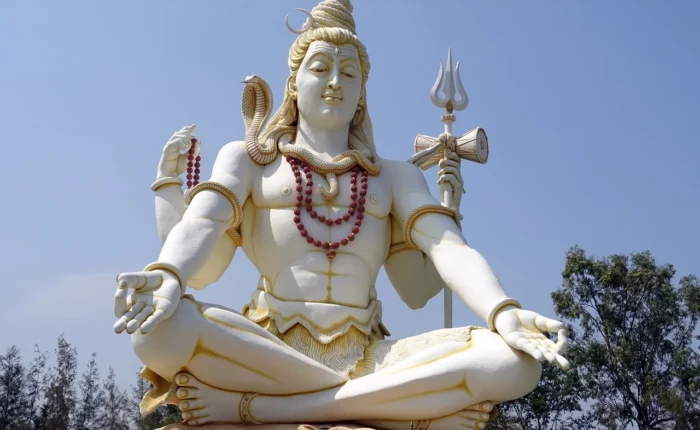Maha Mrityunjaya Jaap and Havan

Maha Mrityunjaya mantra was formulated by Shukracharya who is considered to be the Guru of Rakshas (demons). The mantra is in praise of Lord Shiva. None can define the kindness, powers, and greatness of Lord Shiva. The terms “Shiva” or “Sankara” mean Auspicious. “Sam” means “Chitaananda” (Blissful Awareness) and “Kara” means the one who causes it. Sankara is the One who confers Chitaananda on those who take refuge in him or adore him.
The secret of creation is evident from a description of the form of Shiva. The crescent moon on Shiva’s head symbolizes the consciousness in human beings, the Ganga symbolizes the life force and the snakes on Shiva’s body represent the myriad of living beings.
Jaap or Recitation is the Spiritual Practice of devotedly repeating a mantra several times, generally a specified number of times such as 108, while counting the times on a strand of beads called a Jaap mala. Concentration on the meaning of the Jaap mantra is a form of devotional worship of the deity in mind. The Maha Mrityunjaya Mantra connects the devotees with Lord Shiva.
The Maha Mrityunjaya Mantra is the most powerful of all ancient Sanskrit mantras. It is a mantra that has many names and forms. It is called the Rudra mantra, referring to the furious aspect of Lord Shiva. The Maha Mrityunjaya Jaap is done for long and healthy life and to get rid of prolonged sickness. Its miraculous effects have been noticed by many who organized the Jaap and Havan for people even on the deathbed.
Things needed for Maha Mrityunjaya Jaap?
Pure water or Ganga Jal, un-boiled cow milk, curd, ghee, honey (shahad), sugar (gur-shakkar), white cloth, sacred thread (Janeu), betel nuts (supari), leaves of the holy tulsi, bel-Patra, datura, bhang, white sandalwood (Chandan), unbroken rice (akshata), flowers of aak, kanair, wood-apple (bel fruit), thorn-apple (datura fruit), dhoop, ashes of the funeral pyre, clay lamp, sweets (naivaidya), Ritu phal (seasonal fruits), dry-fruits, perfume, saffron, cloves, camphor, sandalwood stick, incense sticks, aloe wood powder stick, sacred thread (yellow and red threads plaited together) usually called kalaawaa, roli, Kalash, clothes for priests etc.
First step for Maha Mrityunjaya Jaap is Sankalp:
Lord Shiva resides at separate places on separate days. For Sankalp, his stay at three places is considered auspicious.
a) On Kailash
b) With Parvati Ji
c) With Nandi.
For Sankalp for Maha Mrityunjaya Jaap, it is necessary to see that Lord Shiva stays on the above noted three places. The method for finding the place of stay of Lord Shiva is given below:-
First: The Hindi Tithi will be multiplied by 2
Second: Five will be added to the result
Third: The total will be divided by seven
If the balance is:
1 – Shiva resides at Kailash which means Karya Siddhi (success)
2 – Shiva resides with Parvati ji which means Sukh Sampati (pleasure and wealth)
3 – Shiva is with Nandi which means Karya Siddhi (success)
The other places of stay are not considered auspicious for Sankalp of Maha Mrityunjaya Jaap.
Second step for Maha Mrityunjaya is Mantra Jaap:
After taking Sankalp the Jaap is conducted for an agreed number of days (on the basis of the desire of Yajman or the intensity of the problem).
The mantra to be recited is as follows:-
“Om Tryambakkam Yajamahe Sugandhim Pustivardhanam
Urvaarokameva Bandanaan Mrityormooksheya Maamritat”
– Maha Mrityunjaya Mantra
The third Step for Maha Mrityunjaya Jaap is Havan:
A Havan has to be performed after completion of the Maha Mrityunjaya Jaap. Havan must be conducted on the day when Agni dev resides on the earth. The method for finding the residence of Agni is given below.
First: The Hindi Tithi + Vaar is added
Second: One will be added to the result
Third: The total will be divided into four
If the result is 0 or 3, Agni resides on earth and Maha Mrityunjaya Havan can be performed. The mantra used in the Jaap should be used while performing the Havan.
The Maha Mrityunjaya Jaap and Havan ends after the completion of the Havan procedure.
Important Notes: –
1. Counting of Vaar (Hindi days) starts from Sunday which is the Vaar one.
2. For counting in the Shukla Paksha the count of Tithis will be from 1 to 15 and in the Krishna Paksha, the count will begin from 16.
Written by: Jiwanand Mishra
Priest: Ram Mandir, Telco Colony, Jamshedpur
I am a Vedic astrologer by profession. I have done Jyotish Acharya from Bhartiya Vidya Bhawan. I am devoted to my Sadguru Shri Sai Nath of Shirdi. I am also interested in spirituality. I love to guide people.